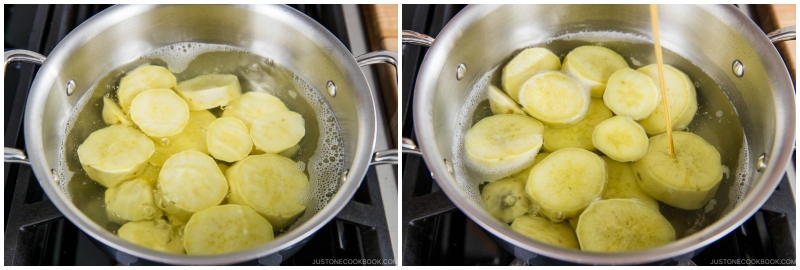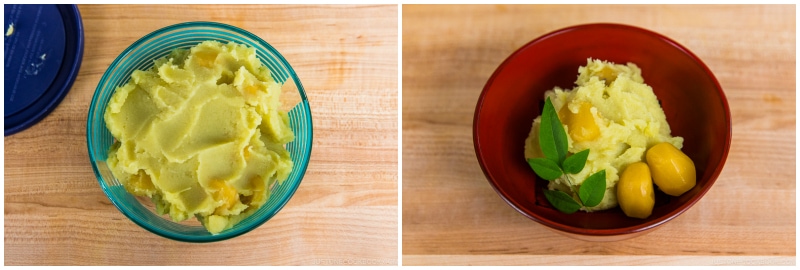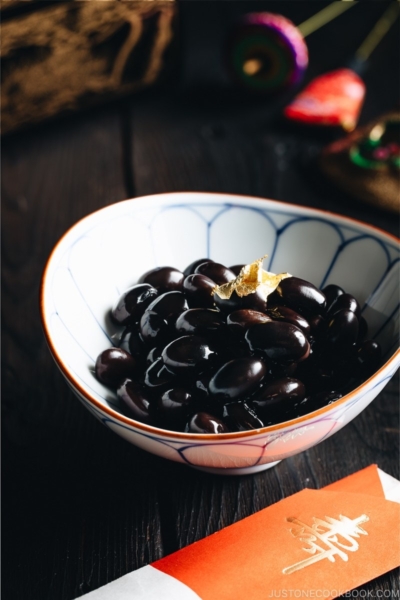Kuri Kinton (Candied Chestnuts and Sweet Potatoes) is a special dish of Osechi Ryori, or traditional Japanese New Year foods. Sweet and slightly nutty, this smooth and creamy dish symbolizes economic fortune and wealth. Let’s make this for a prosperous year ahead!

As part of my Osechi Ryori Recipe Series (traditional Japanese New Year Food), I am bringing you a popular dish called Kuri Kinton or Candied Chestnuts with Sweet Potatoes. This auspicious item is smooth, creamy, slightly nutty with a bright, golden yellow color. It certainly adds a touch of elegance to the New Year’s feast.
What is Kuri Kinton
Kurikinton (栗金団), literary “chestnut gold mash,” symbolizes economic fortune and wealth. Made of mashed sweet potatoes and chestnuts in syrup, kuri kinton is an important dish to bring good luck and prosperity for the new year.

Kuri kinton is on the sweet side, but it is not considered a dessert in Japanese cuisine. You’ll find most traditional osechi ryori dishes are seasoned more heavily with vinegar and sugar so the food are preserved and store well for several days for the New Year. That said, you can always adjust the sweetness to your liking.
Traditionally we put dried gardenia pods (kuchinashi no mi, くちなしの実) while simmering the sweet potatoes. The gardenia pods give a bright yellow color and they are used to naturally color other food such as “takuan” radish pickles and noodles. Unfortunately, I could not find these pods in the US so I couldn’t add them while cooking (Update: you can now find it on Amazon). The yellow color in the photos is purely from the Japanese sweet potatoes.

2 Important Ingredients to Make Kuri Kinton
1. Candied Chestnuts
You can make candied chestnuts from scratch by peeling the chestnuts (this alone takes hours!), cooking them till tender, and preserving them in syrup. But that’s not something most of us have the time to do. So I use this jar of chestnuts in heavy syrup called kuri kanroni (栗甘露煮) for my Kuri Kinton recipe. Kuri kanroni is commonly used in making wagashi, Japanese sweets, such as yokan or manju.

2. Japanese Sweet Potatoes
For kuri kinton, please use only Japanese sweet potatoes called satsumaimo (さつまいも), and not any other types of sweet potatoes. Japanese sweet potatoes are known for its starchy texture and intensely sweet flavor, which makes them an ideal choice for desserts such as Japanese Sweet Potato, Daigaku Imo, and Sweet Potato Pie.
You can easily find them at mainstream grocery stores or local farmers in the US these days.
Learn more about Japanese sweet potatoes on my pantry page.

Both chestnuts and sweet potatoes are signature winter harvests and the epitome of Japanese New Year festivities. You cannot miss it when making osechi for the family!
More Osechi Ryori Dishes
- 7 Popular Side Dishes & Desserts to Serve with Osechi Ryori
- Kuromame (Sweet Black Soybeans)
- Chikuzenni (Simmered Chicken and Vegetables)
- Tataki Gobo (Pounded Burdock Root with Sesame Sauce)

Wish to learn more about Japanese cooking? Sign up for our free newsletter to receive cooking tips & recipe updates! And stay in touch with me on Facebook, Pinterest, YouTube, and Instagram.

Kuri Kinton (Candied Chestnuts and Sweet Potatoes)
Ingredients
- 1.1 lb Japanese sweet potato (Satsumaimo)
- 1 jar kuri kanroni (chestnuts in heavy syrup) (7 oz, 200 g; about 10 chestnuts; also known as marrons glacés)
- ½ cup sugar
- ½ tsp Diamond Crystal kosher salt
- 3 Tbsp syrup from kuri kanroni
- 1 Tbsp mirin
For the Coloring
- 2 kuchinashi no mi (dried gardenia pods) (optional; these pods give a bright yellow tint when simmered with the sweet potatoes; if you can find them, crack the pods in half and wrap in cheesecloth)
Instructions
- Before You Start: If you will include this dish in your Osechi meal, I recommend cooking it 2 days before you plan to serve. For more helpful tips on planning your Japanese New Year feast, please read my A 5-Day Osechi Cooking Timeline blog post.
- Gather all the ingredients.

- Peel 1.1 lb Japanese sweet potato (Satsumaimo) and slice them into ½-inch (1.3-cm) pieces so that they will cook evenly.

- Soak the sweet potatoes in water for 15 minutes to remove the starch. Then, drain and put them in a large pot. Add just enough water to cover them.

- Bring the water to a boil on medium heat. Once boiling, lower the heat to medium low and cook for 15–20 minutes or until a skewer pierces the sweet potatoes smoothly. Then, reserve about ¼–½ cup of the cooking water. Drain the sweet potatoes completely.

- Using a wooden spatula, mash the boiled sweet potatoes through a fine-mesh strainer or sieve to purée them. You can also use a food processor, adding a tiny bit of the reserved cooking liquid if required.

- The finished puréed sweet potato is pictured in the image to the left. Next, remove the chestnuts and syrup for the recipe from 1 jar kuri kanroni (chestnuts in heavy syrup).

- To the same pot, add the puréed sweet potato, ½ cup sugar, ½ tsp Diamond Crystal kosher salt, 1 Tbsp mirin, and 3 Tbsp syrup from kuri kanroni. If you are using the optional 2 kuchinashi no mi (dried gardenia pods), crack them in half and wrap in cheesecloth; then, add to the pot.

- Set the pot on low heat and cook, stirring constantly, until the sugar has dissolved completely. If needed, add the reserved cooking liquid to loosen up the paste (I did not add). Adjust the sweetness with the syrup and mirin.

- Add the chestnuts to the pot and cook until heated through, about 3–5 minutes. Remove from the heat and let it cool completely.

To Serve
- Serve the Kuri Kinton at room temperature.

To Store
- Transfer the Kuri Kinton to an airtight container and store in the refrigerator for up to 3–4 days.
Nutrition
Editor’s Note: This post was originally published on December 28, 2012. The post has been updated with new images in December 2019 and republished in December 2021.








Best place to purchase Kuri Kanroni
Hi Kyoshi,
We are glad to hear you like Kuri Kanroni.
https://www.justonecookbook.com/kuri-kanroni-chestnuts-in-heavy-syrup/#
We purchase this from local Asian or Japanese grocery stores.🙂
Just finished making this! The flavor turned out great and it was easy to follow the recipe.
As a replacement for the kuchinashi I used a little bit of turmeric when I was cooking the sweet potatoes. The color turned out very well, and the flavor wasn’t affected at all!
Hi Ben!
Thank you very much for trying this recipe and sharing your cooking tip with us!
Have a wonderful New Year!😊
Nami FYI. I got the kuchinashi no more from Amazon.
https://www.amazon.com/Gardenia-Fruit-Dried-100-Nature/dp/B0781VMSTD
Hi Shirley! I added the link in the post. Thank you for your information!
Hi
I don’t have Japanese Satsumaimo , and I couldn’t get near from here. But I have Japanese Chestnuts exactly same as your picture !!
So would you tell me substituting for Satsumaimo ? Yam or Sweet Potatoes are different than Japanese one, but if any advice for me, please tell me.
Thank you !!
Hi Yuri! Yeah, Japanese satsumaimo is quite different from American sweet potatoes and they taste different too. What you may not know is that Korean or Chinese grocery stores also carry Satsumaimo this season. So if you haven’t checked, it’s worth visiting Korean grocery stores (more available than Japanese grocery stores). There is nothing that is similar to satsumaimo… you can use American type, BUT since you probably know Kuri Kinton, you may feel a bit strange to combine with American sweet potatoes…
Thank you Nami san
I just got from Philipino mart (small private store) near from my house ( I forgot about that LOL).They are selling Satsumaimo !
Unfortunately Korean or Chinese market are everything Big city near that Japanese Market !
Well, but this time I was lucky that I could get that.
Thank you again and Have wonderful holiday to you and your family !!
Hi Yuri-san! Ahahaha who knew! I’m glad you got Satsumaimo! It’s cool you have a Philipino grocery store. I haven’t seen/been one yet! 😀
Happy Holidays!
Dear Nami,
Thank you for sharing many wonderful recipes online. I often reference your recipes before making dishes. Since I am going to make 栗きんとん this weekend, I naturally use your recipe as a reference and, therefore, learned about your trouble with finding くちなし.
While I was looking for くちなし in New York, I happened to learned that both Chinese and Korean also use くちなし but in a different way as Japanese would. Because くちなし has medicinal properties, it is used as herbal medicine or as tea for Korean and Chinese. You may want to check out Chinese or Korean herbal medicine shops or supermarkets and ask for 黃梔子. Hope you find them the same or similar.
Best,
E-Wei
Hi E-Wei! Thank you for using my website. 🙂 I am so sorry I couldn’t respond sooner. Ohhh thank you for your information! I’ll ask Mr JOC to find a store. Hope your Kuri Kinton came out well. 🙂
Hi Nami,
Thank you for responding to my comment My kuri kinton came out really delicious. Thank you so much for the wonderful recipe. However, I let my kuchinashi no mi stayed in the boiling pot a bit too long so the color came out a bit too strong. Other than that, everything was great. Thanks again. 🙂
E-Wei
Hi E-Wei! I see! Thank you so much for your tip. I’ll remember it when I try it with Kuchinashi. 🙂 I’m glad you enjoyed it. Thank you for writing!
I wonder if a river would work to straighten the potatoes through. Is that too fine?
Hi Geri! I’m sorry but I didn’t understand your question. Could you explain a bit more?
Darn spellcheck! I meant a “ricer” not a river. I did end up using my ricer instead of pushing the potatoes through the sieve as mentioned in the recipe and it worked great. The texture was smooth and the chestnuts provided a nice contrast. I also rant out of sugar in the middle of preparing New Year’s dinner and substituted honey in this recipe. I really liked the honey paired with the sweet potatoes.
Hi Geri! It’s part of my fault for not knowing this kitchen tool “potato ricer”. Even though you mentioned “ricer” I still didn’t know what it is so I had to google! Sorry about that.
I’m glad it worked, and the substitution of honey. That sounds delicious too! Thank you so much for trying this recipe! Hope you had a nice Oshogatsu celebration. 🙂
A ricer is a bit of an obscure kitchen tool for sure! Makes the best mashed potatoes in the world though! My osechi turned out great. Thanks for helping me work in some new recipes this year!
Hi Geri! I’m glad to hear your osechi turned out wonderful! Thank you so much for using my recipes! 🙂
May I ask you where you buy the little red berry with leaves decor?
Hi MJ! I still remember – this was a part of our Christmas bouquet for the table. It was a part of decoration for the flower and I used it for New Years (= two holidays!). 😀 I’m not sure what it is… but it’s typical Christmas theme plants. I was worried that it might look “christmassy” with that flower when I posted it, but no one mentioned so I was glad… haha….. =P
Can you substitute the chestnuts with macadamian nuts?
Hi Riley! Hmm.. I haven’t done that before. If you try and it is good sub, would you please let us know? 🙂
Hi, I bought some fresh chestnuts. Wondering is they can be used for this recipe. If so, how do I modify the recipe? Is it the same as you recommended to Hfriday? Thanks.
Hi Winnie! You have to cook the chestnut till tender (ready to eat). These chestnuts I used are soaked in syrup and very sweet. If you have extra time, I’d soak in syrup (simple syrup) and cook a little bit. It may be a little long process to make this from scratch. I hope this helps.
Thanks a lot Nani. Guess I’ll find chestnuts in syrup to make these then.
Winnie, I think that will save a lot of time to make this dish. I have chestnut rice and roasted chestnut recipes on my blog if you’re interested in using fresh chestnuts. 🙂
My husband who is Japanese and remembers his mothers wonderful cooking says”OISHI!!”
I love cooking special Japanese recipes and following your directions and the pictures are a huge help (and beautiful too) makes cooking very enjoyable. Happy New Year to you, your family and thanks for such a great blog
Hi Nancy! Yay! 😀 Thank you so much for your kind feedback. You and your husband made my day. I hope you enjoy other recipes on my site as well. Happy New Year to you and your family!
Sweet Potatoes in Japan you Betcha– A cold night in December walking down a neighborhood street the smell of Baked Sweet potatoes from a push cart vender pip[ing hot in the hand a little soy sauce HEAVEN and the walk continues..
Happy New Year and thank you Namiko and stay out of the kitchen tomorrow!
Yaki Imo! Oh yes, those are so delicious and I miss eating it too… Thank you for your well wishes, and Happy New Year to you and your family!
My Goodness I have not seen such beautiful and tasty and presentations of food since I was in Japan in 1955-56 and Okinawa in 1963-64. I have seen 4 dishes. Having the Azuki Beans for New Years with mochi. Thank you for bring great beauty into my home. My Japanese preparations are very tasty but not as gorgeous as yours
Thank you for writing! Eating mochi with anko (azuki beans) is my favorite! I’m happy to hear you liked my post. 🙂
What a lovely bowl of goodness! =) Thanks always for your delcious and easy-to-follow recipes, and congratulations on the success of the blog! Looking forward to another year of good eating! Yoroshiku ne~~
Happy (early) New Year to you and your family!!
Arigato Kimmi! Happy New Year to you and your family!
今年はなみさんのレシピで作ってみることにします。
良いお年をお迎えください。
Harumi-san、このレシピ気に入っていただけたら光栄です。お砂糖とシロップの量は、お好みの甘さに加減して、味を見てみて下さいね。良いお年をお迎え下さい。コメントどうもありがとう!:)
Hello! If I’m using marrons glacé in a box, how much should I put? And what can I use instead of the syrup since I’m not using jarred chestnut?
Thank you and hope you and your family have a wonderful new year!
Hi Hfriday! In that case, I suggest to add more sugar and mirin as you are missing syrup, which is quite sweet. While heating the mashed sweet potatoes (step 10), add additional sugar and mirin to your liking. If you have never had this dish, you might think the original recipe is too sweet (especially you are used to typical mashed (sweet) potatoes)…
Thank you for your kind words. Happy New Year to you and your family! 🙂